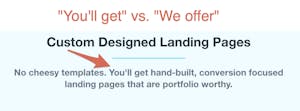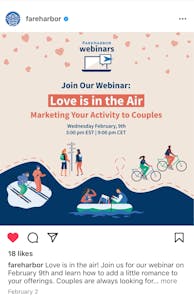- 11 minute read
- Content Marketing
- SEO
Intermediate
Get a behind-the-scenes-look into FareHarbor's 2024 season

Writing is an art – one that can certainly feel hard to master. It’s also an essential part of marketing your tour or activity business, which likely makes you even more enthusiastic to get it right.
Well, there’s no secret formula to nailing your web copy, but there are several techniques you can employ to take your copywriting to the next level and boost your readers’ engagement.
The good news? You don’t need to have an English degree to try out these advanced copywriting strategies. It all comes down to using what works for your business and updating your content to achieve success.
How often do you use the word “we” in your web copy? You might be surprised to find more instances of it than you were expecting. It’s normal to talk about your business – after all, it’s one of the cornerstones of building trust and establishing yourself as an industry expert. But customers want to know what’s in it for them.
Instead of writing about “what we do,” “where we are located,” and “how good our tours or activities are,” reframe your content to address the needs of the customer and tell them what they can expect. Try to replace most instances of “we” with “you.”
Before: Our guides are local experts who know the city by heart.
After: When you book a walking tour with us, you enjoy one-on-one attention from local expert guides who know the city by heart.
Before: We pride ourselves on supporting sustainable, farm-to-table restaurants on our food tours.
After: Your decision to tour with us directly supports sustainable, farm-to-table restaurants in the local community.
This tip also emphasizes the customer over your business. In our guide on writing tour descriptions that sell, we suggest highlighting what makes your tour different. But simply mentioning these features, like your exclusive location or small group size, might not be enough to convert a potential customer.
Benefits are always more convincing than features. Listing what makes your experience amazing is a great starting point. Then, make your copy even more persuasive by sharing what your experience does for customers.
Before: Small group size – only 6 people per lesson!
After: Small group size – with only 6 people per lesson, you’ll enjoy personalized attention from your surf instructor and more support in catching waves.
Before: Enjoy access to our exclusive snorkeling spot, only accessible by boat.
After: Visit our exclusive snorkeling spot, only accessible by boat. Only a handful of visitors get to snorkel here each day, and you could be one of them! Avoid the crowded beaches and enjoy a one-of-a-kind experience on St. Thomas.
 Emotion sells. Emotion drives action. And, of course, emotion is a huge part of traveling and booking tours and activities. Whether people book a trip to visit loved ones, celebrate a milestone or achievement, or just take a break from work, emotions often come into play.
Emotion sells. Emotion drives action. And, of course, emotion is a huge part of traveling and booking tours and activities. Whether people book a trip to visit loved ones, celebrate a milestone or achievement, or just take a break from work, emotions often come into play.
Add to that the fact that tours allow people to share incredible experiences with friends and family, and you’ve got countless opportunities to tap into emotion through your copywriting.
Before: Visit Santa’s workshop! Meet elves, drink hot cocoa and get your child’s photo taken with Santa.
After: Give your children the magic of Christmas with a visit to Santa’s workshop. Delight your little ones with an elf meet-and-greet and hot cocoa station. Don’t forget to have your child’s photo taken with Santa to commemorate this special experience.
Before: Get our Valentine’s Day special two-for-one offer any time during the month of February.
After: Give your loved one a truly romantic experience on our sunset dinner cruise. Don’t miss out! Our special two-for-one offer is only available during the month of February.
Specifics sell, especially numbers. You can use them in blog posts, activity descriptions, social media posts, and pretty much anywhere in your digital marketing efforts. When possible, try to avoid general claims and back that information with specific facts and figures.
Before: See why so many families enroll their kids in our summer camp.
After: See why hundreds of families enroll their kids in our summer camp every year.
Before: The Best Ways To Travel on a Budget
After: 7 Ways To Travel on a Budget
Before: Our Liverpool walking tours stop at some of the area’s top attractions.
After: Our Liverpool walking tours stop at 12 of the area’s top attractions.
 Pro tip: When possible, use crooked numbers, numbers that aren’t rounded (e.g. 57, 12.4, 47.5%). Crooked numbers are more believable than round numbers and can lead to higher conversions.
Pro tip: When possible, use crooked numbers, numbers that aren’t rounded (e.g. 57, 12.4, 47.5%). Crooked numbers are more believable than round numbers and can lead to higher conversions.
Depending on the experiences you offer, you might have one specific audience or different groups of people that tend to show the most interest in your business. For example, city sightseeing tours can cater to a wide range of people from different demographics, while cocktail tours have a more specific 21+ audience.
No matter who you’re addressing, creating buyer personas helps you get specific and personal with your content to boost conversions. Buyer personas are representations of your ideal booker. When you write content for a large group of people, your content can be too broad to get the point across. Buyer personas humanize your customers and allow you to address them directly. Here’s how to make one.
Getting insights on your target buyer’s personal details and preferences will give you a big leg up in actually getting a message across to them. Address them in their own language and communicate in their preferred method. This might mean you have to choose between sharing a post on social media or sending out an email.
Segment your content by persona when necessary. Not every blog post you write will be applicable to everyone, and that’s okay. Keep your content fresh by creating different pieces for different personas and market your content accordingly.
These advanced copywriting strategies can be applied to any piece of content, from a new activity description to a blog post or email. Want a refresher on the basics? See the 10 steps to writing content that sells or get more blogging tips.